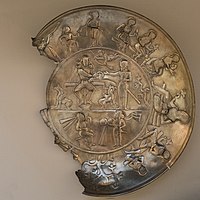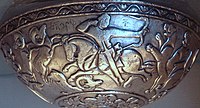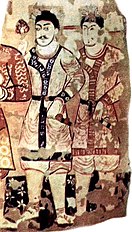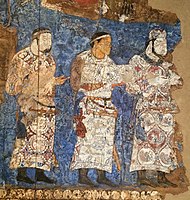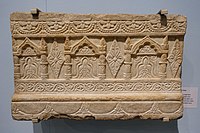Central Asian art
| History of art |
|---|
Central Asian art is visual art created in Central Asia, in areas corresponding to modern Kyrgyzstan, Kazakhstan, Uzbekistan, Turkmenistan, Azerbaijan, Tajikistan, Afghanistan, Pakistan, and parts of modern Mongolia, China and Russia.[1][2] The art of ancient and medieval Central Asia reflects the rich history of this vast area, home to a huge variety of peoples, religions and ways of life. The artistic remains of the region show a remarkable combinations of influences that exemplify the multicultural nature of Central Asian society. The Silk Road transmission of art, Scythian art, Greco-Buddhist art, Serindian art and more recently Persianate culture, are all part of this complicated history.
From the late second millennium BC until very recently, the grasslands of Central Asia – stretching from the Caspian Sea to central China and from southern Russia to northern India – have been home to migrating herders who practised mixed economies on the margins of sedentary societies. The prehistoric 'animal style' art of these pastoral nomads not only demonstrates their zoomorphic mythologies and shamanic traditions but also their fluidity in incorporating the symbols of sedentary society into their own artworks.
Central Asia has always been a crossroads of cultural exchange, the hub of the so-called Silk Road – that complex system of trade routes stretching from China to the Mediterranean. Already in the Bronze Age (3rd and 2nd millennium BC), growing settlements formed part of an extensive network of trade linking Central Asia to the Indus Valley, Mesopotamia and Egypt.[3]
The arts of recent centuries are mainly influenced by Islamic art, but the varied earlier cultures were influenced by the art of China, Persia and Greece, as well as the Animal style that developed among the nomadic peoples of the steppes.[4]
Early nomadic cultures (3500-2500 BC)[]
The Afanasevo culture resulted from the eastward migration of the Yamnaya culture, originally based in the Pontic steppe north of the Caucasus Mountains.[6] The Afanasevo culture (c. 3500–2500 BC) displays cultural and genetic connections with the Indo-European-associated cultures of the Central Asian steppe yet predates the specifically Indo-Iranian-associated Andronovo culture (c. 2000–900 BC).
Tarim mummies[]
The oldest of the Tarim mummies, bodies preserved by the desert conditions, date from 2000 BC and were found on the eastern edge of the Tarim basin. They seem to be Caucasoid types with light-colored hair.[7] A genetic study of remains from the oldest layer of the Xiaohe Cemetery found that the maternal lineages were a mixture of east and west Eurasian types, while all the paternal lineages were of west Eurasian type.[8] It is unknown whether they are connected with the frescoes painted at Tocharian sites more than two millennia later, which also depict light eyes and hair color.
The mummies were found with plaid-woven tapestries that are notably similar to the weaving pattern of the "tartan" style of the Hallstatt culture of central Europe, associated with Celts; the wool used in the tapestries was found to come from sheep with European ancestry.[9]
Later, groups of nomadic pastoralists moved from the steppe into the grasslands to the north and northeast of the Tarim. They were the ancestors of peoples later known to Chinese authors as the Wusun and Yuezhi.[10] It is thought that at least some of them spoke Iranian languages,[10] but a minority of scholars suggest that the Yuezhi were Tocharian speakers.[11][12]
Bronze Age[]
The Bactria–Margiana Archaeological Complex (BMAC, also known as the "Oxus civilization") is the modern archaeological designation for a Bronze Age archaeological culture of Central Asia, dated to c. 2200–1700 BC, located in present-day eastern Turkmenistan, northern Afghanistan, southern Uzbekistan and western Tajikistan, centred on the upper Amu Darya (known to the ancient Greeks as the Oxus River), an area covering ancient Bactria. Its sites were discovered and named by the Soviet archaeologist Viktor Sarianidi (1976). Bactria was the Greek name for Old Persian Bāxtriš (from native *Bāxçiš)[13] (named for its capital Bactra, modern Balkh), in what is now northern Afghanistan, and Margiana was the Greek name for the Persian satrapy of Margu, the capital of which was Merv, in today's Turkmenistan.
Fertility goddesses, named "Bactrian princesses", made from limestone, chlorite and clay reflect agrarian Bronze Age society, while the extensive corpus of metal objects point to a sophisticated tradition of metalworking.[14] Wearing large stylised dresses, as well as headdresses that merge with the hair, "Bactrian princesses" embody the ranking goddess, character of the central Asian mythology that plays a regulatory role, pacifying the untamed forces.[citation needed]
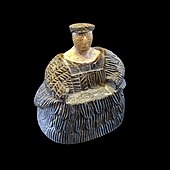
Female figurine of the "Bactrian princess" type; between 3rd millennium and 2nd millennium BC; chlorite mineral group (dress and headdresses) and limestone (face and neck); height: 17.3 cm, width: 16.1 cm; Louvre

Ancient bowl with animals, Bactria, 3rd–2nd millennium BC.

Axe with eagle-headed demon & animals; late 3rd millennium-early 2nd millennium BC; gilt silver; length: 15 cm; Metropolitan Museum of Art (New York City)
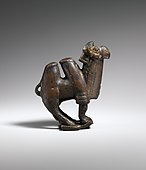
Camel figurine; late 3rd–early 2nd millennium BCE; copper alloy; 8.89 cm; Metropolitan Museum of Art
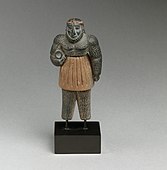
Monstrous male figure; late 3rd–early 2nd millennium BC; chlorite, calcite, gold and iron; height: 10.1 cm; Metropolitan Museum of Art

Handled weight; late 3rd–early 2nd millennium BC; chlorite; 25.08 x 19.69 x 4.45 cm; Los Angeles County Museum of Art (USA)

Female figurine of the "Bactrian princess" type; 2500–1500; chlorite (dress and headdresses) and limestone (head, hands and a leg); height: 13.33 cm; Los Angeles County Museum of Art (USA)

Beaker with birds on the rim; late 3rd–early 2nd millennium BC; electrum; height: 12 cm, width: 13.3 cm, depth: 4.5 cm; Metropolitan Museum of Art
Scythian cultures[]
Pazyrik culture (6th-3rd century BC)[]
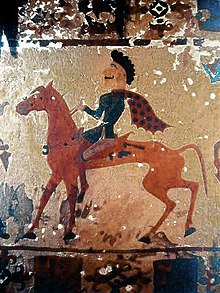
The Pazyryk culture is a Scythian[15] nomadic Iron Age archaeological culture (of Iranian origin; c. 6th to 3rd centuries BC) identified by excavated artifacts and mummified humans found in the Siberian permafrost, in the Altay Mountains, Kazakhstan and nearby Mongolia. The mummies are buried in long barrows (or kurgans) similar to the tomb mounds of Scythian culture in Ukraine. The type site are the Pazyryk burials of the Ukok Plateau.[16] Many artifacts and human remains have been found at this location, including the Siberian Ice Princess, indicating a flourishing culture at this location that benefited from the many trade routes and caravans of merchants passing through the area.[17] The Pazyryk are considered to have had a war-like life.[18]
Other kurgan cemeteries associated with the culture include those of Bashadar, Tuekta, Ulandryk, Polosmak and Berel. There are so far no known sites of settlements associated with the burials, suggesting a purely nomadic lifestyle.
The remarkable textiles recovered from the Pazyryk burials include the oldest woollen knotted-pile carpet known, the oldest embroidered Chinese silk, and two pieces of woven Persian fabric (State Hermitage Museum, St. Petersburg). Red and ochre predominate in the carpet, the main design of which is of riders, stags, and griffins. Many of the Pazyryk felt hangings, saddlecloths, and cushions were covered with elaborate designs executed in appliqué feltwork, dyed furs, and embroidery. Of exceptional interest are those with animal and human figural compositions, the most notable of which are the repeat design of an investiture scene on a felt hanging and that of a semihuman, semibird creature on another (both in the State Hermitage Museum, St. Petersburg). Clothing, whether of felt, leather, or fur, was also lavishly ornamented.
Horse reins either had animal designs cut out on them or were studded with wooden ones covered in gold foil. Their tail sheaths were ornamented, as were their headpieces and breastpieces. Some horses were provided with leather or felt masks made to resemble animals, with stag antlers or rams’ horns often incorporated in them. Many of the trappings took the form of iron, bronze, and gilt wood animal motifs either applied or suspended from them; and bits had animal-shaped terminal ornaments. Altai-Sayan animals frequently display muscles delineated with dot and comma markings, a formal convention that may have derived from appliqué needlework. Such markings are sometimes included in Assyrian, Achaemenian, and even Urartian animal representations of the ancient Middle East. Roundels containing a dot serve the same purpose on the stag and other animal renderings executed by contemporary Śaka metalworkers. Animal processions of the Assyro-Achaemenian type also appealed to many Central Asian tribesmen and are featured in their arts.
Certain geometric designs and sun symbols, such as the circle and rosette, recur at Pazyryk but are completely outnumbered by animal motifs. The stag and its relatives figure as prominently as in Altai-Sayan. Combat scenes between carnivores and herbivores are exceedingly numerous in Pazyryk work; the Pazyryk beasts are locked in such bitter fights that the victim's hindquarters become inverted.[19]

Pazyryk carpet

Pazyryk saddlecloth.

Decorated tapestry with seated goddess Tabiti and rider, Pazyryk Kurgan 5, Altai, Southern Russia c. 241 BCE.[20]
Bronze plaque of a man of the Ordos Plateau, long held by the Xiongnu. 3-1stCentury BC, British Museum. Otto Maenchen-Helfen notes that the statuette displays Caucasoid features.[21]
Sakas[]

The art of the Saka was of a similar styles as other Iranian peoples of the steppes, which is referred to collectively as Scythian art. In 2001, the discovery of an undisturbed royal Scythian burial-barrow illustrated Scythian animal-style gold that lacks the direct influence of Greek styles. Forty-four pounds of gold weighed down the royal couple in this burial, discovered near Kyzyl, capital of the Siberian republic of Tuva.
Ancient influences from Central Asia became identifiable in China following contacts of metropolitan China with nomadic western and northwestern border territories from the 8th century BC. The Chinese adopted the Scythian-style animal art of the steppes (descriptions of animals locked in combat), particularly the rectangular belt-plaques made of gold or bronze, and created their own versions in jade and steatite.[23]
Following their expulsion by the Yuezhi, some Saka may also have migrated to the area of Yunnan in southern China. Saka warriors could also have served as mercenaries for the various kingdoms of ancient China. Excavations of the prehistoric art of the Dian civilisation of Yunnan have revealed hunting scenes of Caucasoid horsemen in Central Asian clothing.[24]
Saka influences have been identified as far as Korea and Japan. Various Korean artifacts, such as the royal crowns of the kingdom of Silla, are said to be of "Scythian" design.[25] Similar crowns, brought through contacts with the continent, can also be found in Kofun era Japan.[26]
Flying elk with griffin burial mound, Issyk kurgan (5th-4th century BC) Kazakhstan.
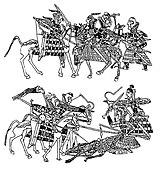
Battle scenes on the Orlat plaques. 1st century CE.
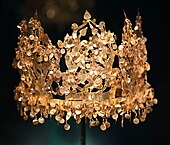
Crown from Tomb VI of Tillya Tepe (female owner)
Achaemenid period[]

Margiana and Bactria belonged to the Medes for a time, and were then annexed to the Achaemenid Empire by Cyrus the Great in sixth century BC, forming the twelfth satrapy of Persia.[28][29]
Under Persian rule, many Greeks were deported to Bactria, so that their communities and language became common in the area. During the reign of Darius I, the inhabitants of the Greek city of Barca, in Cyrenaica, were deported to Bactria for refusing to surrender assassins.[30] In addition, Xerxes also settled the "Branchidae" in Bactria; they were the descendants of Greek priests who had once lived near Didyma (western Asia Minor) and betrayed the temple to him.[31] Herodotus also records a Persian commander threatening to enslave daughters of the revolting Ionians and send them to Bactria.[32] Persia subsequently conscripted Greek men from these settlements in Bactria into their military, as did Alexander later.[33]
Hellenistic and Greco-Bactrian art (265-145 BCE)[]
The Greco-Bactrians ruled the southern part of Central Asia from the 3rd to the 2nd century BC, with their capital at Ai-Khanoum.[34][35][36]
The main known remains from this period are the ruins and artifacts of their city of Ai-Khanoum, a Greco-Bactrian city founded circa 280 BCE which continued to flourish during the first 55 years of the Indo-Greek period until its destruction by nomadic invaders in 145 BCE, and their coinage, which is often bilingual, combining Greek with the Indian Brahmi script or Kharoshthi.[37] Apart from Ai-Khanoum, Indo-Greek ruins have been positively identified in few cities such as Barikot or Taxila, with generally much fewer known artistic remains.[35][38]
Architecture in Bactria[]
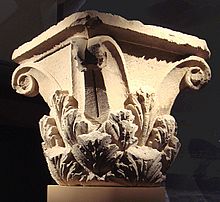
Numerous artefacts and structures were found, particularly in Ai-Khanoum, pointing to a high Hellenistic culture, combined with Eastern influences, starting from the 280-250 BCE period.[39][40][41] Overall, Aï-Khanoum was an extremely important Greek city (1.5 sq kilometer), characteristic of the Seleucid Empire and then the Greco-Bactrian Kingdom, remaining one of the major cities at the time when the Greek kings started to occupy parts of India, from 200 to 145 BCE. It seems the city was destroyed, never to be rebuilt, about the time of the death of king Eucratides around 145 BC.[41]
Archaeological missions unearthed various structures, some of them perfectly Hellenistic, some other integrating elements of Persian architecture, including a citadel, a Classical theater, a huge palace in Greco-Bactrian architecture, somehow reminiscent of formal Persian palatial architecture, a gymnasium (100 × 100m), one of the largest of Antiquity, various temples, a mosaic representing the Macedonian sun, acanthus leaves and various animals (crabs, dolphins etc...), numerous remains of Classical Corinthian columns.[41] Many artifacts are dated to the 2nd century BCE, which corresponds to the early Indo-Greek period.

Ai- Khanoum mosaic (central detail in color).

Architectural antefixae with Hellenistic "Flame palmette" design, Ai-Khanoum.

Sun dial within two sculpted lion feet.

Winged antefix, a type only known from Ai-Khanoum.
Sculpture[]
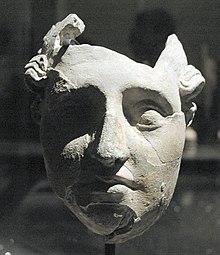
Various sculptural fragments were also found at Ai-Khanoum, in a rather conventional, classical style, rather impervious to the Hellenizing innovations occurring at the same time in the Mediterranean world. Of special notice, a huge foot fragment in excellent Hellenistic style was recovered, which is estimated to have belonged to a 5-6 meter tall statue (which had to be seated to fit within the height of the columns supporting the Temple). Since the sandal of the foot fragment bears the symbolic depiction of Zeus' thunderbolt, the statue is thought to have been a smaller version of the Statue of Zeus at Olympia.[42][43]
Due to the lack of proper stones for sculptural work in the area of Ai-Khanoum, unbaked clay and stucco modeled on a wooden frame were often used, a technique which would become widespread in Central Asia and the East, especially in Buddhist art. In some cases, only the hands and feet would be made in marble.
In India, only a few Hellenistic sculptural remains have been found, mainly small items in the excavations of Sirkap.
Sculpture of an old man. Ai-Khanoum, 2nd century BC.

Close-up of the same statue.

Frieze of a naked man wearing a chlamys. Ai-Khanoum, 2nd century BC.

Hellenistic gargoyle. Ai-Khanoum, 2nd century BC.
Artefacts[]

A variety of artefacts of Hellenistic style, often with Persian influence, were also excavated at Ai-Khanoum, such as a round medallion plate describing the goddess Cybele on a chariot, in front of a fire altar, and under a depiction of Helios, a fully preserved bronze statue of Herakles, various golden serpentine arm jewellery and earrings, a toilet tray representing a seated Aphrodite, a mold representing a bearded and diademed middle-aged man. Various artefacts of daily life are also clearly Hellenistic: sundials, ink wells, tableware. An almost life-sized dark green glass phallus with a small owl on the back side and other treasures are said to have been discovered at Ai-Khanoum, possibly along with a stone with an inscription, which was not recovered. The artefacts have now been returned to the Kabul Museum after several years in Switzerland by Paul Bucherer-Dietschi, Director of the Swiss Afghanistan Institute.[44]

Bronze Herakles statuette. Ai-Khanoum. 2nd century BC.

Bracelet with horned female busts. Ai-Khanoum, 2nd century BC.

Stone recipients from Ai-Khanoum. 3rd-2nd century BC.

Imprint from a mold found in Ai-Khanoum. 3rd-2nd century BC.
Yuezhi and Kushan art[]
Some traces remain of the presence of the Kushans in the areas of Bactria and Sogdiana. Archaeological structures are known in Takht-I-Sangin, Surkh Kotal (a monumental temple), and in the palace of Khalchayan. Various sculptures and friezes are known, representing horse-riding archers, and, significantly, men with artificially deformed skulls, such as the Kushan prince of Khalchayan (a practice well attested in nomadic Central Asia).[45]
Khalchayan (1st century BCE)[]
The art of Khalchayan of the end of the 2nd-1st century BCE is probably one of the first known manifestations of Kushan art.[51] It is ultimately derived from Hellenistic art, and possibly from the art of the cities of Ai-Khanoum and Nysa.[51] At Khalchayan, rows of in-the-round terracotta statues showed Kushan princes in dignified attitudes, while some of the sculptural scenes are thought to depict the Kushans fighting against the Sakas.[52] The Yuezis are shown with a majestic demeanour, whereas the Sakas are typically represented with side-wiskers, displaying expressive and sometimes grotesque features.[52]
According to Benjamin Rowland, the styles and ethnic type visible in Kalchayan already anticipate the characteristics of the later Art of Gandhara and may even have been at the origin of its development.[51] Rowland particularly draws attention to the similarity of the ethnic types represented at Khalchayan and in the art of Gandhara, and also in the style of portraiture itself.[51] For example, Rowland find a great proximity between the famous head of a Yuezhi prince from Khalchayan, and the head of Gandharan Bodhisattvas, giving the example of the Gandharan head of a Bodhisattva in the Philadelphia Museum.[51] The similarity of the Gandhara Bodhisattva with the portrait of the Kushan ruler Heraios is also striking.[51] According to Rowland the Bactrian art of Khalchayan thus survived for several centuries through its influence in the art of Gandhara, thanks to the patronage of the Kushans.[51]
Bactria (1st-3rd century CE)[]
The Kushans apparently favoured royal portraiture, as can be seen in their coins and their dynastic sculptures.[53] A monumental sculpture of King Kanishka I has been found in Mathura in northern India, which is characterized by its frontality and martial stance, as he holds firmly his sword and a mace.[53] His heavy coat and riding boots are typically nomadic Central Asian, and are way too heavy for the warm climate of India.[53] His coat is decorated by hundreds of pearls, which probably symbolize his wealth.[53] His grandiose regnal title is inscribed in the Brahmi script: "The Great King, King of Kings, Son of God, Kanishka".[54][53]
As the Kushans progressively adapted to life in India, their dress progressively became lighter, and representation less frontal and more natural, although they retained characteristic elements of their nomadic dress, such as the trousers and boots, the heavy tunics, and heavy belts.

Early Kushan ruler Heraios (1–30 CE), from his coinage.
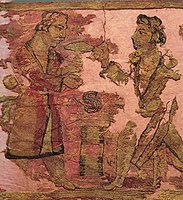
Figures in the embroidered carpets of the Noin-Ula burial site, made in Bactria and proposed to represent Yuezhis (1st century BC - 1st century AD).[55][56][57]
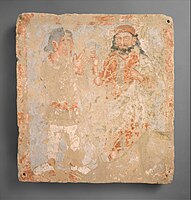
Kushan worshiper with deity Zeus/ Serapis/ Ohrmazd, Bactria, 3rd century CE.[58]
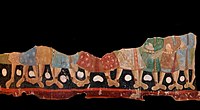
Kushan men in caftan and boots, at Fayaz Tepe
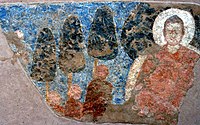
Buddhist mural in Kara Tepe, 2nd-4th century CE.

Buddhist pillar capital from Surkh Kotal, with central Buddha figure.
Kushano-Sasanian art (3rd-4th century AD)[]
The Kushano-Sasanian Kingdom (also called "Kushanshas" KΟÞANΟ ÞAΟ Koshano Shao in Bactrian[60]) is a historiographic term used by modern scholars[61] to refer to a branch of the Sasanian Persians who established their rule in Bactria and in northwestern Indian subcontinent (present day Pakistan) during the 3rd and 4th centuries CE at the expense of the declining Kushans. They captured the provinces of Sogdiana, Bactria and Gandhara from the Kushans in 225 AD.[62] The Kushano-Sassanids traded goods such as silverware and textiles depicting the Sassanid emperors engaged in hunting or administering justice. The example of Sassanid art was influential on Kushan art, and this influence remained active for several centuries in northwest South Asia.
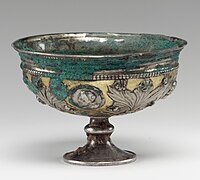
Kushano-Sasanian footed cup with medallion, 3rd-4th century CE, Bactria, Metropolitan Museum of Art.[63]

Terracotta head of a male figure, Kushano-Sasanian period, Gandhara region, 4th-5th century CE
Huns[]
The Huns were a nomadic people who lived in Central Asia, the Caucasus, and Eastern Europe between the 4th and 6th century AD. The nomadic nature of Hun society means that they have left very little in the archaeological record.[67] Archaeological finds have produced a large number of cauldrons that have since the work of Paul Reinecke in 1896 been identified as having been produced by the Huns.[68] Although typically described as "bronze cauldrons", the cauldrons are often made of copper, which is generally of poor quality.[69] Maenchen-Helfen lists 19 known finds of Hunnish cauldrons from all over Central and Eastern Europe and Western Siberia.[70] They come in various shapes, and are sometimes found together with vessels of various other origins.[71]
Both ancient sources and archaeological finds from graves confirm that the Huns wore elaborately decorated golden or gold-plated diadems.[72] Maenchen-Helfen lists a total of six known Hunnish diadems.[73] Hunnic women seem to have worn necklaces and bracelets of mostly imported beads of various materials as well.[74] The later common early medieval practice of decorating jewelry and weapons with gemstones appears to have originated with the Huns.[75] They are also known to have made small mirrors of an originally Chinese type, which often appear to have been intentionally broken when placed into a grave.[76]
Archaeological finds indicate that the Huns wore gold plaques as ornaments on their clothing, as well as imported glass beads.[77] Ammianus reports that they wore clothes made of linen or the furs of marmots and leggings of goatskin.[78]
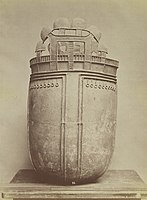
A Hunnish cauldron
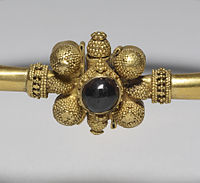
Detail of Hunnish gold and garnet bracelet, 5th century, Walters Art Museum
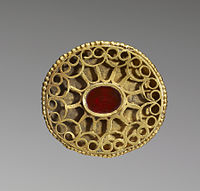
A Hunnish oval openwork fibula set with a carnelian and decorated with a geometric pattern of gold wire, 4th century, Walters Art Museum
Kidarites[]
The Kidarites, or "Kidara Huns",[81] were a dynasty that ruled Bactria and adjoining parts of Central Asia and South Asia in the 4th and 5th centuries. The Kidarites belonged to a complex of peoples known collectively in India as the Huna, and in Europe as the Chionites (from the Iranian names Xwn/Xyon), and may even be considered as identical to the Chionites.[82] The 5th century Byzantine historian Priscus called them Kidarites Huns, or "Huns who are Kidarites".[83][84] The Huna/ Xionite tribes are often linked, albeit controversially, to the Huns who invaded Eastern Europe during a similar period. They are entirely different from the Hephthalites, who replaced them about a century later.[84]

Kidarite tamga symbol (
 ) appears to the right of the standing king. Balkh mint.
) appears to the right of the standing king. Balkh mint.
Silver bowl, showing an Alchon horseman

Two Kidarite princes on the Hephthalite bowl
Hepthalite art (4th-6th century CE)[]
The Hephthalites (Bactrian: ηβοδαλο, romanized: Ebodalo),[90] sometimes called the "White Huns",[91][92] were a people who lived in Central Asia during the 5th to 8th centuries. They existed as an Empire, the "Imperial Hephthalites", and were militarily important from 450 CE, when they defeated the Kidarites, to 560 CE, date of their defeat to combined First Turkic Khaganate and Sasanian Empire forces.[93][94]
The Hepthalites appears in several mural paintings in the area of Tokharistan, especially in banquet scenes at Balalyk tepe and as donors to the Buddha in the ceiling painting of the 35 meter Buddha at the Buddhas of Bamiyan.[95] Several of the figures in these paintings have a characteristic appearance, with belted jackets with a unique lapel of their tunic being folded on the right side, a style which became popular under the Hephthalites,[96] the cropped hair, the hair accessories, their distinctive physionomy and their round beardless faces.[97][98] The figures at Bamiyan must represent the donors and potentates who supported the building of the monumental giant Buddha.[97] These remarkable paintings participate "to the artistic tradition of the Hephthalite ruling classes of Tukharistan".[95][99]
The paintings related to the Hephthalites have often been grouped under the appellation of "Tokharistan school of art",[100] or the "Hephthalite stage in the History of Central Asia Art".[101] The paintings of Tavka Kurgan, of very high quality, also belong to this school of art, and are closely related to other paintings of the Tokharistan school such as Balalyk tepe, in the depiction of clothes, and especially in the treatment of the faces.[102]
This "Hephthalite period" in art, with the caftans with a triangular collar folded on the right, the particular cropped hairstyle, the crowns with crescents, have been found in many of the areas historically occupied and ruled by the Hephthalites, in Sogdia, Bamiyan (modern Afghanistan), or in Kucha in the Tarim Basin (modern Xinjiang, China). This points to a "political and cultural unification of Central Asia" with similar artistic styles and iconography, under the rule of the Hephthalites.[103]
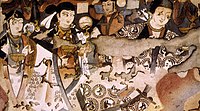
Banquet scene, Balalyk Tepe

Probable Hephthalite royal couple in the murals of the Buddhas of Bamiyan circa 600 CE (the 38 meter Buddha they decorate is carbon dated to 544 - 595 CE).[105]

Stamp seal with a bearded figure in Sasanian dress, wearing the kulāf denoting nobility and officials; and a figure with radiate crown,[106] both with royal ribbons. Attributed to the Hephthalites,[107] and recently dated to the 5th-6th century CE.[108] Stamp seal (BM 119999), British Museum.
Buddhist art of Bamiyan[]
The Buddhist art of Bamiyan covers a period from the early centuries of the Common Era, culminating with the building of the Buddhas of Bamiyan in the 6th-century CE.[111] monumental statues of Gautama Buddha carved into the side of a cliff in the Bamyan valley of central Afghanistan, 130 kilometres (81 mi) northwest of Kabul at an elevation of 2,500 metres (8,200 ft). Carbon dating of the structural components of the Buddhas has determined that the smaller 38 m (125 ft) "Eastern Buddha" was built around 570 AD, and the larger 55 m (180 ft) "Western Buddha" was built around 618 AD.[105][110]
The statues represented a later evolution of the classic blended style of Gandhara art.[112] The statues consisted of the male Salsal ("light shines through the universe") and the (smaller) female Shamama ("Queen Mother"), as they were called by the locals.[113] The main bodies were hewn directly from the sandstone cliffs, but details were modeled in mud mixed with straw, coated with stucco. This coating, practically all of which wore away long ago, was painted to enhance the expressions of the faces, hands, and folds of the robes; the larger one was painted carmine red and the smaller one was painted multiple colors.[114] The lower parts of the statues' arms were constructed from the same mud-straw mix supported on wooden armatures. It is believed that the upper parts of their faces were made from great wooden masks or casts. The rows of holes that can be seen in photographs held wooden pegs that stabilized the outer stucco.
The Buddhas are surrounded by numerous caves and surfaces decorated with paintings.[115] It is thought that the period of florescence was from the 6th to 8th century CE, until the onset of Islamic invasions.[115] These works of art are considered as an artistic synthesis of Buddhist art and Gupta art from India, with influences from the Sasanian Empire and the Byzantine Empire, as well as the country of Tokharistan.[115]
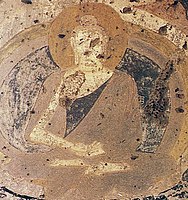
Buddha, Cave 404 in Bamiyan.

Sun-God Surya on his chariot
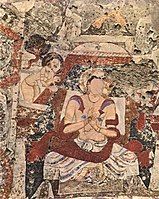
Western Buddha, Niche, ceiling, east section E1 and E2.[118]
Tarim Basin[]

From the 3rd century AD, the Tarim Basin became a centre for the development of Buddhist art, and a major relay for the Silk Road transmission of Buddhism. Buddhist texts were translated into Chinese by Kuchean monks, the most famous of whom was Kumārajīva (344–412/5).[119][120]
Indian and Central Asian influences[]
Numerous Buddhist caves cover the northern side of the Tarim Basin, such as the Kizil Caves consisting in over 236 such temples. Their murals date from the 3rd to the 8th century.[121] The caves of Kizil are the earlier of their type in China, and their model was later adopted in the construction of Buddhist caves further east.[122] Other famous sites nearby are the Kizilgaha caves, the Kumtura Caves, Subashi Temple or the Simsim caves.[123][124]
In the Kizil Caves appear portraits of Royal families, composed of the King, Queen and young Prince. They are accompanied by monks, and men in caftan.[125] According to Historian of Art Benjamin Rowland, these portraits show "that the Tocharians were European rather than Mongol in appearance, with light complexions, blue eyes, and blond or reddish hair, and the costumes of the knights and their ladies have haunting suggestions of the chivalric age of the West".[126]
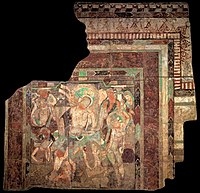
The mural, "Dance of princess Chandraprabha", with frames probably derived from Roman art of the 1st century CE.[127] Treasure Cave C (Cave 83). MIK III 8443.
Painting of a cowherd listening to a sermon of the Buddha, from the right wall of the main hall. Cave of the Statues. 14C date: 406-425 CE.[128]

Maitreya in the lunette over the entrance of Maya Cave, 224, Kizil Caves. Dahlem Museum
Interaction with Chinese art[]
The influence of Chinese art started to appear in the eastern part of the Tarim Basin, as Buddhist art was spreading eastward. These Chinese characteristics appear in the art of the Bezeklik Caves or the Dunhuang Caves.
Praṇidhi scene, temple 9 (Cave 20), including Sogdian merchants. Bezeklik Caves.[129]

Details from Praṇidhi scene No. 5. Central Asian and Asian Buddhist monks.[129]

Bodhisattva leading a lady donor towards the Pure Lands. Painting on silk (Library Cave), Late Tang. Mogao Caves
Figure of Maitreya Buddha in cave 275 from Northern Liang (397–439), one of the earliest caves. The crossed ankle figure with a three-disk crown shows influence from Kushan art. Mogao Caves
Sogdian Art[]
The Afrasiab paintings of the 6th to 7th centuries in Samarkand, Uzbekistan offer a rare surviving example of Sogdian art. The paintings, showing scenes of daily life and events such as the arrival of foreign ambassadors, are located within the ruins of aristocratic homes. It is unclear if any of these palatial residences served as the official palace of the rulers of Samarkand.[130] The oldest surviving Sogdian monumental wall murals date to the 5th century and are the Penjikent murals, Tajikistan.[131] In addition to revealing aspects of their social and political lives, Sogdian art has also been instrumental in aiding historians' understanding of their religious beliefs. For instance, it is clear that Buddhist Sogdians incorporated some of their own Iranian deities into their version of the Buddhist Pantheon. At Zhetysu, Sogdian gilded bronze plaques on a Buddhist temple show a pairing of a male and female deity with outstretched hands holding a miniature camel, a common non-Buddhist image similarly found in the paintings of Samarkand and Panjakent.[132]
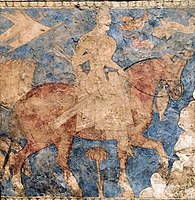
Rostam, with an elongated skull, Penjikent murals
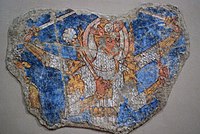
Multi-armed deity in armour: "A King of the Demons". Penjikent murals, 8th century CE.[139]
Turkic art[]
The Turks overran the Hephthalite Empire and became the main power in Central Asia from the time of the First Turkic Khaganate and the Western Turks, circa 560 to 742 AD. Their art was essentially nomadic.

Gold Mask Inlaid with Rubies, probably belonging to the Turkic Empire of Central Asia. 5th - 6th century CE. Excavated at Boma Tomb in Zhaosu County, Xinjiang. Ili Kazakh Autonomous Prefecture Museum collection.[140]
Warrior statue; 8th-10th century; from the Kosh-Agach region (Altai); Hermitage (Sankt Petersburg, Russia)

Knights in Kucha, Tarim Basin, following the events of 552 CE and the subsequent Turk expansion. Kizil Caves, 2nd half of the 6th century CE.[141]
Islamic Golden Age in Central Asia[]
The Muslim conquest of Transoxiana was the 7th and 8th century conquests, by Umayyad and Abbasid Arabs, of Transoxiana, the land between the Oxus (Amu Darya) and Jaxartes (Syr Darya) rivers, a part of Central Asia that today includes all or parts of Uzbekistan, Tajikistan, Kazakhstan, and Kyrgyzstan. This started a period of prosperity, from the 8th to the 14th century, known as the Islamic Golden Age, which also affected the arts of Central Asia.
Samanids[]
Artistic florescence occurred especially during the period of the Samanid Empire (819-999 AD). The empire was centred in Khorasan and Transoxiana; at its greatest extent encompassing modern-day Afghanistan, large parts of Iran, Tajikistan, Turkmenistan, Uzbekistan, Kyrgyzstan, parts of Kazakhstan and Pakistan.
The Samanid Mausoleum, the burial site of Ismail Samani, in Bukhara, 10th century.
Samanid Mausoleum, exterior detail with pointed arches and spandrels

Artwork of Isma'il Muntasir in a battle.
[]
The Ghaznavid dynasty was a Persianate[145] Muslim dynasty of Turkic mamluk origin,[146][a][147] at their greatest extent ruling large parts of Iran, Afghanistan, much of Transoxiana and the northwest Indian subcontinent from 977 to 1186.[148]
Seljuks[]
The Seljuk Empire (1037–1194 AD) was a high medieval Turko-Persian Sunni Muslim empire, originating from the Qiniq branch of Oghuz Turks. At its greatest extent, the Seljuk Empire controlled a vast area stretching from western Anatolia and the Levant to the Hindu Kush in the east, and from Central Asia to the Persian Gulf in the south.
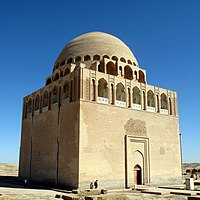
Mausoleum of Sultan Sanjar in Merv, Turkmenistan.

Seljuk-era art: Ewer from Herat, Afghanistan, dated 1180–1210CE. Brass worked in repousse and inlaid with silver and bitumen. British Museum.
Mongol invasion[]
The Mongols under Genghis Khan invaded Central Asia in the early 13th century. The unified Mongol Empire was succeeded by the Chagatai Khanate,[149] a Mongol and later Turkicized khanate.[150][151] that comprised the lands ruled by Chagatai Khan, second son of Genghis Khan and his descendants and successors. At its height in the late 13th century, the khanate extended from the Amu Darya south of the Aral Sea to the Altai Mountains in the border of modern-day Mongolia and China, roughly corresponding to the defunct Qara Khitai Empire.[152] Initially the rulers of the Chagatai Khanate recognized the supremacy of the Great Khan,[153] but by the reign of Kublai Khan, Ghiyas-ud-din Baraq no longer obeyed the emperor's orders.
Timurid Renaissance[]
During the mid-14th century, the Chagatais lost Transoxania to the Timurids circa 1370. After the Mongol invasions, a new period of prosperity thus started, the Timurid Renaissance. After conquering a city, the Timurids commonly spared the lives of the local artisans and deported them to the Timurid capital of Samarkand. After the Timurids conquered Persia in the early 15th century, many Persian artistic traits became interwoven with existing Mongol art. Timur made Samarkand one of the centers of Islamic art and remained a subject of interest to Ibn Khaldun.[154] In the mid 15th century the empire moved its capital to Herat, which became a focal point for Timurid art. As with Samarkand, Persian artisans and intellectuals soon established Herat as a center for arts and culture. Soon, many of the Timurids adopted Persian culture as their own.[155]

Mausoleum of Khoja Ahmed Yasawi in Hazrat-e Turkestan, Kazakhstan. Timurid architecture consisted of Persian art.
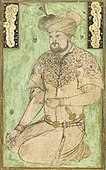
Sultan Husayn Bayqara,a patron of Art, constructed multiple centers of learning.

Akhangan's tomb, where Gawhar Shad's sister Gowhartāj is buried. The architecture is a fine example of the Timurid era in Persia.
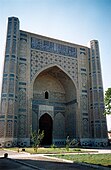
Façade of Bibi Khanym Mosque, Samarkand.
Khanate of Bukhara and Khanate of Khiva[]
The Khanate of Bukhara was a state centered on Uzbekistan from the second quarter of the 16th century to the late 18th century. Bukhara became the capital of the short-lived Shaybanid empire during the reign of Ubaydallah Khan (1533–1540). The khanate reached its greatest extent and influence under its penultimate Shaybanid ruler, the scholarly Abdullah Khan II (r. 1557–1598). In the 17th and 18th centuries, the Khanate was ruled by the (Astrakhanids or Toqay Timurids). They were the last Genghisid descendants to rule Bukhara.

Chor Bakr memorial complex, Bukhara

Imamkuli-khan

The Registan and its three madrasahs. From left to right: Ulugh Beg Madrasah, Tilya-Kori Madrasah and Sher-Dor Madrasah.

Suzani (ceremonial hanging); late 1700s; cotton; 92 × 63; from Uzbekistan; Indianapolis Museum of Art (US)
Russian Turkestan (1867–1917)[]
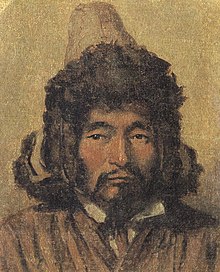
Central Asia fell largely under the control of Russia in the 19th century, following the Russian conquest of Central Asia. Russian Turkestan (1867–1917) was the western part of Turkestan within the Russian Empire's Central Asian territories, and was administered as a Krai or Governor-Generalship. It comprised the oasis region to the south of the Kazakh Steppe, but not the protectorates of the Emirate of Bukhara and the Khanate of Khiva. As a consequence of Russian colonization, European fine arts – painting, sculpture and graphics – have developed in Central Asia.
The Emir of Bukhara and the notables of the city watch how the heads of Russian soldiers are impaled on poles. Samarkand

Russian troops taking Samarkand in 1868

They Attack Unaware
Soviet Central Asia (1918–1991)[]
Soviet Central Asia refers to the section of Central Asia formerly controlled by the Soviet Union, as well as the time period of Soviet administration (1918–1991). Central Asian SSRs declared independence in 1991. In terms of area, it is nearly synonymous with Russian Turkestan, the name for the region during the Russian Empire. The first years of the Soviet regime saw the appearance of modernism, which took inspiration from the Russian avant-garde movement. Until the 1980s, Central Asian arts had developed along with general tendencies of Soviet arts.

Urging peasants to speed up cotton production – Russian and Uzbek, Tashkent, 1920s
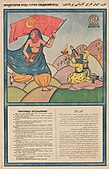
"Female Muslims- The tsar, beys and khans took your rights away" – Azeri, Baku, 1921 (Mardjani).

Poster of 3 different men with the word "friendship" underneath. Central Asia

Emblem of the Turkmen SSR.
Contemporary period[]

In the 90s, arts of the region underwent some significant changes. Institutionally speaking, some fields of arts were regulated by the birth of the art market, some stayed as representatives of official views, while many were sponsored by international organizations. The years of 1990–2000 were times for the establishment of contemporary arts. In the region, many important international exhibitions are taking place, Central Asian art is represented in European and American museums, and the Central Asian Pavilion at the Venice Biennale has been organized since 2005.
References[]
- ^ Tamara Talbot Rice (July 2011). Visual Arts. Oxford.
- ^ Fahir İz. Central Asian Literature.
- ^ Fortenberry, Diane (2017). THE ART MUSEUM. Phaidon. p. 66. ISBN 978-0-7148-7502-6.
- ^ Encyclopædia Britannica, Central Asian Arts. 2012. Retrieved May 17, 2012. Encyclopædia Britannica.
- ^ Narasimhan, Vagheesh M.; Patterson, Nick; Moorjani, Priya; Rohland, Nadin; Bernardos, Rebecca (6 September 2019). "The formation of human populations in South and Central Asia". Science. 365 (6457). doi:10.1126/science.aat7487. ISSN 0036-8075.
- ^ Allentoft, ME (June 11, 2015). "Population genomics of Bronze Age Eurasia" (PDF). Nature. Nature Research. 522 (7555): 167–172. Bibcode:2015Natur.522..167A. doi:10.1038/nature14507. PMID 26062507. S2CID 4399103.
- ^ Mallory & Mair (2000), pp. 181–182.
- ^ Li et al. (2010).
- ^ Fortson, Benjamin W. 2004. Indo-European Language and Culture. Blackwell Publishing. Page 352: "Adding to the various mysteries surrounding the Tocharians is the existence of extremely well-preserved mummies in the Takla Makan desert that have striking Europoid features and often red hair; some are nearly 4,000 years old. The mummies were found with tapestries woven in plaids that are similar in weaving style and pattern to tartans from the Hallstatt culture of central Europe, which was ancestral to the Celts... the wool used in weaving the tapestries comes from sheep of European ancestry..."
- ^ Jump up to: a b Mallory & Mair (2000), p. 318.
- ^ John E. Hill (2009). Through the Jade Gate to Rome. Booksurge Publishing. p. 311. ISBN 978-1-4392-2134-1.
- ^ Beckwith (2009), pp. 84, 380–383.
- ^ David Testen, "Old Persian and Avestan Phonology", Phonologies of Asia and Africa, vol. II (Winona Lake, Indiana: Eisenbrauns, 1997), 583.
- ^ Fortenberry, Diane (2017). THE ART MUSEUM. Phaidon. p. 66. ISBN 978-0-7148-7502-6.
- ^ The Editors (2001-09-11). "Pazyryk | archaeological site, Kazakhstan". Britannica.com. Retrieved 2019-03-05.
- ^ (NOVA 2007)
- ^ (State Hermitage Museum 2007)
- ^ (Jordana 2009)
- ^ "Altaic Tribes". Encyclopædia Britannica Online. Encyclopædia Britannica. Retrieved December 5, 2016.
- ^ Atwood, Christopher P.; Andreeva, Petya. "Camp and audience scenes in late iron age rock drawings from Khawtsgait, Mongolia": 4. Cite journal requires
|journal=(help) - ^ Helfen-Maenchen,-Helfen, Otto (1973). The World of the Huns: Studies of Their History and Culture, pp.371. Berkeley, California: University of California Press. p. 371.
- ^ Chang, Claudia (2017). Rethinking Prehistoric Central Asia: Shepherds, Farmers, and Nomads. Routledge. p. 72. ISBN 9781351701587.
- ^ Mallory and Mair, The Tarim Mummies: Ancient China and the Mystery of the Earliest Peoples from the West, 2000)
- ^ "Les Saces", Iaroslav Lebedynsky, p.73 ISBN 2-87772-337-2
- ^ Crowns similar to the Scythian ones discovered in Tillia Tepe "appear later, during the 5th and 6th century at the eastern edge of the Asia continent, in the tumulus tombs of the Kingdom of Silla, in South-East Korea. "Afganistan, les trésors retrouvés", 2006, p282, ISBN 978-2-7118-5218-5
- ^ "金冠塚古墳 – Sgkohun.world.coocan.jp". Archived from the original on 2011-07-22. Retrieved 2010-12-14.
- ^ Hartley, Charles W.; Yazicioğlu, G. Bike; Smith, Adam T. (2012). The Archaeology of Power and Politics in Eurasia: Regimes and Revolutions. Cambridge University Press. p. 83. ISBN 978-1-107-01652-1.
- ^ Herzfeld, Ernst (1968). The Persian Empire: Studies in geography and ethnography of the ancient Near East. F. Steiner. p. 344.
- ^ "BACTRIA – Encyclopaedia Iranica". www.iranicaonline.org. Retrieved 2019-08-07.
After annexation to the Persian empire by Cyrus in the sixth century, Bactria together with Margiana formed the Twelfth Satrapy.
- ^ Herodotus, 4.200–204
- ^ Strabo, 11.11.4
- ^ Herodotus 6.9
- ^ Graeco-Bactrian Kingdom
- ^ "Bopearachchi attributes the destruction of Ai Khanoum to the Yuezhi, rather than to the alternative 'conquerors' and destroyers of the last vestiges of Greek power in Bactria, the Sakas..." Benjamin, Craig (2007). The Yuezhi: Origin, Migration and the Conquest of Northern Bactria. Isd. p. 180. ISBN 9782503524290.
- ^ Jump up to: a b Singh, Upinder (2008). A History of Ancient and Early Medieval India: From the Stone Age to the 12th Century. Pearson Education India. p. 373. ISBN 9788131716779.
- ^ Holt, Frank Lee (1999). Thundering Zeus : the making of Hellenistic Bactria. University of California Press. pp. 135–136. ISBN 9780520920095.
- ^ Singh, Upinder (2008). A History of Ancient and Early Medieval India: From the Stone Age to the 12th Century. Pearson Education India. p. 374. ISBN 9788131716779.
- ^ Behrendt, Kurt A. (2007). The Art of Gandhara in the Metropolitan Museum of Art. Metropolitan Museum of Art. p. 7. ISBN 9781588392244.
- ^ "It has all the hallmarks of a Hellenistic city, with a Greek theatre, gymnasium and some Greek houses with colonnaded courtyards" (Boardman).
- ^ Singh, Upinder (2008). A History of Ancient and Early Medieval India: From the Stone Age to the 12th Century. Pearson Education India. p. 375. ISBN 9788131716779.
- ^ Jump up to: a b c Holt, Frank Lee (1999). Thundering Zeus: The Making of Hellenistic Bactria. University of California Press. pp. 43–44. ISBN 9780520920095.
- ^ Thapar, Romila (2004). Early India: From the Origins to AD 1300. University of California Press. pp. 215–216. ISBN 9780520242258.
- ^ Bernard, Paul (1967). "Deuxième campagne de fouilles d'Aï Khanoum en Bactriane". Comptes rendus des séances de l'Académie des Inscriptions et Belles-Lettres. 111 (2): 306–324. doi:10.3406/crai.1967.12124.
- ^ Source, BBC News, Another article. German story with photographs here (translation here).
- ^ Fedorov, Michael (2004). "On the origin of the Kushans with reference to numismatic and anthropological data" (PDF). Oriental Numismatic Society. 181 (Autumn): 32. Archived from the original (PDF) on 2019-10-06. Retrieved 2021-02-15.

- ^ KHALCHAYAN – Encyclopaedia Iranica. p. Figure 1.
- ^ "View in real colors".
- ^ Abdullaev, Kazim (2007). "Nomad Migration in Central Asia (in After Alexander: Central Asia before Islam)". Proceedings of the British Academy. 133: 87–98.
- ^ Greek Art in Central Asia, Afghan – Encyclopaedia Iranica.
- ^ Also a Saka according to this source
- ^ Jump up to: a b c d e f g Rowland, Benjamin (1971). "Graeco-Bactrian Art and Gandhāra: Khalchayan and the Gandhāra Bodhisattvas". Archives of Asian Art. 25: 29–35. ISSN 0066-6637. JSTOR 20111029.
- ^ Jump up to: a b "The knights in chain-mail armour have analogies in the Khalchayan reliefs depicting a battle of the Yuezhi against a Saka tribe (probably the Sakaraules). Apart from the chain-mail armour worn by the heavy cavalry of the enemies of the Yuezhi, the other characteristic sign of these warriors is long side-whiskers (...) We think it is possible to identify all these grotesque personages with long side-whiskers as enemies of the Yuezhi and relate them to the Sakaraules (...) Indeed these expressive figures with side-whiskers differ greatly from the tranquil and majestic faces and poses of the Yuezhi depictions." Abdullaev, Kazim (2007). "Nomad Migration in Central Asia (in After Alexander: Central Asia before Islam)". Proceedings of the British Academy. 133: 89.
- ^ Jump up to: a b c d e Stokstad, Marilyn; Cothren, Michael W. (2014). Art History 5th Edition CH 10 Art Of South And Southeast Asia Before 1200. Pearson. pp. 306–308. ISBN 978-0205873470.
- ^ Puri, Baij Nath (1965). India under the Kushāṇas. Bharatiya Vidya Bhavan.
- ^ Yatsenko, Sergey A. (2012). "Yuezhi on Bactrian Embroidery from Textiles Found at Noyon uul, Mongolia" (PDF). The Silk Road. 10.
- ^ Polosmak, Natalia V. (2012). "History Embroidered in Wool". SCIENCE First Hand. 31 (N1).
- ^ Polosmak, Natalia V. (2010). "We Drank Soma, We Became Immortal…". SCIENCE First Hand. 26 (N2).
- ^ "Panel with the god Zeus/Serapis/Ohrmazd and worshiper". www.metmuseum.org. Metropolitan Museum of Art.
- ^ Marshak, Boris; Grenet, Frantz (2006). "Une peinture kouchane sur toile". Comptes rendus des séances de l'Académie des Inscriptions et Belles-Lettres. 150 (2): 947–963. doi:10.3406/crai.2006.87101. ISSN 0065-0536.
- ^ Rezakhani, Khodadad. From the Kushans to the Western Turks. p. 204.
- ^ Rezakhani 2017, p. 72.
- ^ The Cambridge History of Iran, Volume 3, E. Yarshater p.209 ff
- ^ "Metropolitan Museum of Art". www.metmuseum.org.
- ^ For the precise date: Sundermann, Werner; Hintze, Almut; Blois, François de. Exegisti Monumenta: Festschrift in Honour of Nicholas Sims-Williams. Otto Harrassowitz Verlag. p. 284, note 14. ISBN 978-3-447-05937-4.
- ^ "Plate British Museum". The British Museum.
- ^ Sims, Vice-President Eleanor G.; Sims, Eleanor; Marshak, Boris Ilʹich; Grube, Ernst J.; I, Boris Marshak. Peerless Images: Persian Painting and Its Sources. Yale University Press. p. 13. ISBN 978-0-300-09038-3.
- ^ Thompson 1996, pp. 6–7.
- ^ Maenchen-Helfen 1973, p. 306.
- ^ Maenchen-Helfen 1973, pp. 321–322.
- ^ Maenchen-Helfen 1973, p. 307-318.
- ^ Maenchen-Helfen 1973, p. 323.
- ^ Maenchen-Helfen 1973, p. 297.
- ^ Maenchen-Helfen 1973, pp. 299–306.
- ^ Maenchen-Helfen 1973, p. 357.
- ^ Kim 2015, p. 170.
- ^ Maenchen-Helfen 1973, pp. 352–354.
- ^ Maenchen-Helfen 1973, pp. 354–356.
- ^ Thompson 1996, p. 47.
- ^ The Cambridge Companion to the Age of Attila, Michael Maas, Cambridge University Press, 2014 p.284 ff
- ^ Encyclopedia Iranica
- ^ Bakker, Hans T. The Alkhan: A Hunnic People in South Asia. Barkhuis. p. 17. ISBN 978-94-93194-00-7.
- ^ Bakker, Hans T. The Alkhan: A Hunnic People in South Asia. Barkhuis. p. 10. ISBN 978-94-93194-00-7.
- ^ Cribb 2010, p. 91.
- ^ Jump up to: a b Dani, Ahmad Hasan; Litvinsky, B. A. (1996). History of Civilizations of Central Asia: The crossroads of civilizations, A.D. 250 to 750. UNESCO. pp. 119–120. ISBN 9789231032110.
- ^ KURBANOV, AYDOGDY (2010). THE Hephthalites: Archeological and Historical Analysis (PDF). Berlin: Berlin Freie Universität. pp. 135–136.
- ^ "DelbarjīnELBARJĪN – Encyclopaedia Iranica". www.iranicaonline.org.
- ^ Ilyasov, Jangar. "The Hephthalite Terracotta // Silk Road Art and Archaeology. Vol. 7. Kamakura, 2001, 187–200": 187–197. Cite journal requires
|journal=(help) - ^ Dani, Ahmad Hasan; Litvinsky, B. A. (January 1996). History of Civilizations of Central Asia: The crossroads of civilizations, A.D. 250 to 750. UNESCO. p. 183. ISBN 978-92-3-103211-0.
- ^ Lerner, Judith A.; Sims-Williams, Nicholas (2011). Seals, sealings and tokens from Bactria to Gandhara : 4th to 8th century CE. Wien: Verlag der Österreichischen Akademie der Wissenschaften. p. 36. ISBN 978-3700168973.
- ^ Dani, Ahmad Hasan; Litvinsky, B. A. (January 1996). History of Civilizations of Central Asia: The crossroads of civilizations, A.D. 250 to 750. UNESCO. p. 177. ISBN 978-92-3-103211-0.
- ^ Dignas, Assistant Professor of History Beate; Dignas, Beate; Winter, Engelbert (2007). Rome and Persia in Late Antiquity: Neighbours and Rivals. Cambridge University Press. p. 97. ISBN 978-0-521-84925-8.
- ^ Goldsworthy, Adrian (2009). The Fall Of The West: The Death Of The Roman Superpower. Orion. ISBN 978-0-297-85760-0.
- ^ Rezakhani, Khodadad. From the Kushans to the Western Turks. p. 208.
- ^ Benjamin, Craig (16 April 2015). The Cambridge World History: Volume 4, A World with States, Empires and Networks 1200 BCE–900 CE. Cambridge University Press. p. 484. ISBN 978-1-316-29830-5.
- ^ Jump up to: a b c Azarpay, Guitty; Belenickij, Aleksandr M.; Maršak, Boris Il'ič; Dresden, Mark J. (January 1981). Sogdian Painting: The Pictorial Epic in Oriental Art. University of California Press. pp. 92–93. ISBN 978-0-520-03765-6.
- ^ "Il’yasov's article references figurines wearing caftans with triangular-shaped collars on the right side. This is believed to be a style of garment that became popular in Central Asia under Hephthalite rule" in Kageyama, Etsuko (2016). "Change of suspension systems of daggers and swords in eastern Eurasia: Its relation to the Hephthalite occupation of Central Asia" (PDF). ZINBUN. 46: 200.
- ^ Jump up to: a b c Margottini, Claudio (20 September 2013). After the Destruction of Giant Buddha Statues in Bamiyan (Afghanistan) in 2001: A UNESCO's Emergency Activity for the Recovering and Rehabilitation of Cliff and Niches. Springer Science & Business Media. pp. 12–13. ISBN 978-3-642-30051-6.
- ^ Jump up to: a b Azarpay, Guitty; Belenickij, Aleksandr M.; Maršak, Boris Il'ič; Dresden, Mark J. Sogdian Painting: The Pictorial Epic in Oriental Art. University of California Press. pp. 92–93. ISBN 978-0-520-03765-6.
- ^ Jump up to: a b KURBANOV, Aydogdy (2010). "The Hephthalites: Archaeological and Historical Analysis" (PDF): 67. Cite journal requires
|journal=(help) - ^ Kurbanov, Aydogdy (2014). "THE HEPHTHALITES: ICONOGRAPHICAL MATERIALS" (PDF). Tyragetia. VIII: 322.
- ^ Ilyasov, Jangar. "The Hephthalite Terracotta // Silk Road Art and Archaeology. Vol. 7. Kamakura, 2001, 187–200": 187. Cite journal requires
|journal=(help) - ^ Grenet, Frantz (15 May 2004). "Tavka (k istorii drevnix tamožennyx sooruženij Uzbekistana). Taškent-Samarkand, Izd. A. Kadyri / Institut Arxeologii A.N. Uzb, 141 p., 68 ill. + 13 pl. couleurs h.-t. (Texte bilingue ouzbek-russe, résumé en anglais). [Tavka (contribution à l'histoire des anciens édifices frontaliers de l'Ouzbékistan)]". Abstracta Iranica. Revue bibliographique pour le domaine irano-aryen (in French). 25. doi:10.4000/abstractairanica.4213. ISSN 0240-8910.
- ^ Kageyama (Kobe City University of Foreign Studies, Kobe, Japan), Etsuko (2007). "The Winged Crown and the Triple-crescent Crown in the Sogdian Funerary Monuments from China: Their Relation to the Hephthalite Occupation of Central Asia" (PDF). Journal of Inner Asian Art and Archaeology. 2: 12. doi:10.1484/J.JIAAA.2.302540. S2CID 130640638. Archived from the original (PDF) on 2020-11-11.CS1 maint: multiple names: authors list (link)
- ^ Higham, Charles (14 May 2014). Encyclopedia of Ancient Asian Civilizations. Infobase Publishing. pp. 141–142. ISBN 978-1-4381-0996-1.
- ^ Jump up to: a b Eastern Buddha: 549 AD - 579 AD (1 σ range, 68.2% probability) 544 AD - 595 AD (2 σ range, 95.4% probability). Western Buddha: 605 AD - 633 AD (1 σ range, 68.2%) 591 AD - 644 AD (2 σ range, 95.4% probability). in Blänsdorf, Catharina (2015). "Dating of the Buddha Statues – AMS 14C Dating of Organic Materials". Cite journal requires
|journal=(help) - ^ The radiate crown is comparable to the crown of the king on the "Yabghu of the Hephthalites" seal. See: Lerner, Judith A.; Sims-Williams, Nicholas (2011). Seals, sealings and tokens from Bactria to Gandhara : 4th to 8th century CE. Wien: Verlag der Österreichischen Akademie der Wissenschaften. pp. 35–36. ISBN 978-3700168973.
- ^ KURBANOV, AYDOGDY (2010). THE HEPHTHALITES: ARCHAEOLOGICAL AND HISTORICAL ANALYSIS (PDF). Berlin: Berlin Freie Universität. p. 69, item 1).
- ^ Latest 5th-6th century CE date in Livshits (2000) LIVSHITS, V. A. (2000). "Sogdian Sānak, a Manichaean Bishop of the 5th–Early 6th Centuries" (PDF). Bulletin of the Asia Institute. 14: 48. ISSN 0890-4464.. According to earlier sources (Bivar (1969) and Livshits (1969), repeated by the British Museum the seal was dated to the 300-350 CE: in Naymark, Aleksandr. "SOGDIANA, ITS CHRISTIANS AND BYZANTIUM: A STUDY OF ARTISTIC AND CULTURAL CONNECTIONS IN LATE ANTIQUITY AND EARLY MIDDLE AGES" (PDF): 167. Cite journal requires
|journal=(help), "Stamp-seal; bezel British Museum". The British Museum. - ^ Blänsdorf, Catharina (2015). "Dating of the Buddha Statues – AMS 14C Dating of Organic Materials". Cite journal requires
|journal=(help) - ^ Jump up to: a b Petzet (Ed.), Michael (2009). The Giant Buddhas of Bamiyan. Safeguarding the remains (PDF). ICOMOS. pp. 18–19.CS1 maint: extra text: authors list (link)
- ^ Gall, Carlotta (5 December 2006). "Afghans consider rebuilding Bamiyan Buddhas". International Herald Tribune/The New York Times. Retrieved 8 March 2014.
- ^ Morgan, Kenneth W (1956). The Path of the Buddha. p. 43. ISBN 978-8120800304. Retrieved 2 June 2009 – via Google Books.
- ^ "booklet web E.indd" (PDF). Retrieved 9 October 2013.
- ^ Gall, Carlotta (6 December 2006). "From Ruins of Afghan Buddhas, a History Grows". The New York Times. Retrieved 6 January 2008.
- ^ Jump up to: a b c Higuchi, Takayasu; Barnes, Gina (1995). "Bamiyan: Buddhist Cave Temples in Afghanistan". World Archaeology. 27 (2): 299. ISSN 0043-8243.
- ^ Alram, Michael; Filigenzi, Anna; Kinberger, Michaela; Nell, Daniel; Pfisterer, Matthias; Vondrovec, Klaus. "The Countenance of the other (The Coins of the Huns and Western Turks in Central Asia and India) 2012-2013 exhibit: 14. KABULISTAN AND BACTRIA AT THE TIME OF "KHORASAN TEGIN SHAH"". Pro.geo.univie.ac.at. Kunsthistorisches Museum Vienna. Retrieved July 16, 2017.
- ^ "The globelike crown of the princely donor has parallels in Sasanian coin portraits. Both this donor and the Buddha at the left are adorned with hair ribbons or kusti, again borrowed the Sasanian royal regalia" in Rowland, Benjamin (1975). The art of Central Asia. New York, Crown. p. 88.
- ^ "Lost, Stolen, and Damaged Images: The Buddhist Caves of Bamiyan". huntingtonarchive.org.
- ^ Walter (1998), pp. 5–9.
- ^ Hansen (2012), p. 66.
- ^ Walter (1998), pp. 21–17.
- ^ 阮, 荣春. 佛教艺术经典第三卷佛教建筑的演进 (in Chinese). Beijing Book Co. Inc. p. 184. ISBN 978-7-5314-6376-4.
- ^ (Other than Kizil)... "The nearby site of Kumtura contains over a hundred caves, forty of which contain painted murals or inscriptions. Other cave sites near Kucha include Subashi, Kizilgaha, and Simsim." in Buswell, Robert E.; Lopez, Donald S. (24 November 2013). The Princeton Dictionary of Buddhism. Princeton University Press. p. 438. ISBN 978-1-4008-4805-8.
- ^ Vignato, Giuseppe (2006). "Archaeological Survey of Kizil: Its Groups of Caves, Districts, Chronology and Buddhist Schools". East and West. 56 (4): 359–416. ISSN 0012-8376. JSTOR 29757697.
- ^ References BDce-888、889, MIK III 8875, now in the Hermitage Museum."俄立艾爾米塔什博物館藏克孜爾石窟壁畫". www.sohu.com (in Chinese).
- ^ Rowland, Benjamin (1975). The art of Central Asia. New York, Crown. p. 155.
- ^ Rhie, Marylin Martin (15 July 2019). Early Buddhist Art of China and Central Asia, Volume 2 The Eastern Chin and Sixteen Kingdoms Period in China and Tumshuk, Kucha and Karashahr in Central Asia (2 vols). BRILL. pp. 651 ff. ISBN 978-90-04-39186-4.
- ^ Waugh, Daniel (Historian, University of Washington). "Kizil". depts.washington.edu. Washington University. Retrieved 30 December 2020.
- ^ Jump up to: a b von Le Coq, Albert. (1913). Chotscho: Facsimile-Wiedergaben der Wichtigeren Funde der Ersten Königlich Preussischen Expedition nach Turfan in Ost-Turkistan
- ^ A. M. Belenitskii and B. I. Marshak (1981), "Part One: the Paintings of Sogdiana" in Guitty Azarpay, Sogdian Painting: the Pictorial Epic in Oriental Art, Berkeley, Los Angeles, London: University of California Press, p. 47, ISBN 0-520-03765-0.
- ^ A. M. Belenitskii and B. I. Marshak (1981), "Part One: the Paintings of Sogdiana" in Guitty Azarpay, Sogdian Painting: the Pictorial Epic in Oriental Art, Berkeley, Los Angeles, London: University of California Press, p. 13, ISBN 0-520-03765-0.
- ^ A. M. Belenitskii and B. I. Marshak (1981), "Part One: the Paintings of Sogdiana" in Guitty Azarpay, Sogdian Painting: the Pictorial Epic in Oriental Art, Berkeley, Los Angeles, London: University of California Press, pp 34–35, ISBN 0-520-03765-0.
- ^ Whitfield, Susan (2004). The Silk Road: Trade, Travel, War and Faith. British Library. Serindia Publications, Inc. p. 110. ISBN 978-1-932476-13-2.
- ^ Compareti (University of California, Berkeley), Matteo (2007). "The Chinese Scene at Afrāsyāb". Eurasiatica.
- ^ Baumer, Christoph (18 April 2018). History of Central Asia, The: 4-volume set. Bloomsbury Publishing. p. 243. ISBN 978-1-83860-868-2.
- ^ Whitfield, Susan (2004). The Silk Road: Trade, Travel, War and Faith. British Library. Serindia Publications, Inc. p. 110. ISBN 978-1-932476-13-2.
- ^ Grenet, Frantz (2004). "Maracanda/Samarkand, une métropole pré-mongole". Annales. Histoire, Sciences Sociales. 5/6: Fig. D.
- ^ Compareti (University of California, Berkeley), Matteo (2015). "Ancient Iranian Decorative Textiles". The Silk Road. 13: 38.
- ^ Mode, Markus; Tubach, Jürgen; Vashalomidze, G. Sophia. Arms and Armour as Indicators of Cultural Transfer: The Steppes and the Ancient World from Hellenistic Times to the Early Middle Ages (in German). Reichert. p. 86. ISBN 978-3-89500-529-9.
- ^ Giumlía-Mai, Alessandra (2013). "METALLURGY AND TECHNOLOGY OF THE HUNNIC GOLD HOARD FROM NAGYSZÉKSÓS" (PDF). The Silkroad Foundation: 21, Fig 14.
- ^ Kubik, Adam (2018). "The Kizil Caves as an terminus post quem of the Central and Western Asiatic pear-shape spangenhelm type helmets The David Collection helmet and its place in the evolution of multisegmented dome helmets, Historia i Świat nr 7/2018, 141-156". Historia i Swiat. 7: 145–148.
- ^ Göbl 1967, 254 ; Vondrovec tyre 254
- ^ Alram, Michael; Filigenzi, Anna; Kinberger, Michaela; Nell, Daniel; Pfisterer, Matthias; Vondrovec, Klaus. "The Countenance of the other". Pro.geo.univie.ac.at. Kunsthistorisches Museum Vienna. Retrieved July 16, 2017.
- ^ Alram, Michael; Filigenzi, Anna; Kinberger, Michaela; Nell, Daniel; Pfisterer, Matthias; Vondrovec, Klaus. "The Countenance of the other (The Coins of the Huns and Western Turks in Central Asia and India) 2012-2013 exhibit: 13. THE TURK SHAHIS IN KABULISTAN". Pro.geo.univie.ac.at. Kunsthistorisches Museum Vienna. Retrieved July 16, 2017.
- ^ Arjomand 2012, p. 410-411.
- ^ Jump up to: a b Levi & Sela 2010, p. 83.
- ^ Bosworth 1963, p. 4.
- ^ Bosworth 2006.
- ^ Frederik Coene (2009). The Caucasus - An Introduction. Routledge. p. 114. ISBN 978-1135203023.
- ^ Black, Cyril E.; Dupree, Louis; Endicott-West, Elizabeth; Matuszewski, Daniel C.; Naby, Eden; Waldron, Arthur N. (1991). The Modernization of Inner Asia. Armonk, N.Y.: M.E. Sharpe. p. 57. ISBN 978-1-315-48899-8. Retrieved 20 November 2016.
- ^ Upshur, Jiu-Hwa L.; Terry, Janice J.; Holoka, Jim; Cassar, George H.; Goff, Richard D. (2011). Cengage Advantage Books: World History (5th ed.). Cengage Learning. p. 433. ISBN 978-1-133-38707-7. Retrieved 20 November 2016.
- ^ See Barnes, Parekh and Hudson, p. 87; Barraclough, p. 127; Historical Maps on File, p. 2.27; and LACMA for differing versions of the boundaries of the khanate.
- ^ Dai Matsui – A Mongolian Decree from the Chaghataid Khanate Discovered at Dunhuang. Aspects of Research into Central Asian Buddhism, 2008, pp. 159–178
- ^ Marozzi, Justin (2004). Tamerlane: Sword of Islam, conqueror of the world. HarperCollins.
- ^ B.F. Manz; W.M. Thackston; D.J. Roxburgh; L. Golombek; L. Komaroff; R.E. Darley-Doran (2007). "Timurids". Encyclopedia of Islam, online edition. "During the Timurid period, three languages, Persian, Turkish, and Arabic were in use. The major language of the period was Persian, the native language of the Tajik (Persian) component of society and the language of learning acquired by all literate and/or urban Turks. Persian served as the language of administration, history, belles lettres, and poetry."
Sources[]
- Arjomand, Said Amir (2012). "Patrimonial state". In Böwering, Gerhard; Crone, Patricia; Mirza, Mahan (eds.). The Princeton Encyclopedia of Islamic Political Thought. Princeton University Press.
- Levi, Scott Cameron; Sela, Ron, eds. (2010). Islamic Central Asia: an anthology of historical sources. Indiana University Press.
- Bosworth, C.E. (1963). The Ghaznavids:994–1040. Edinburgh University Press.
- Bosworth, C.E. (1968). "The Development of Persian Culture under the Early Ghaznavids". Iran. Taylor & Francis, Ltd. 6: 33–44. doi:10.2307/4299599. JSTOR 4299599.
- Walter, Mariko Namba (1998), "Tocharian Buddhism in Kucha: Buddhism of Indo-European Centum Speakers in Chinese Turkestan before the 10th Century C.E." (PDF), Sino-Platonic Papers, 85.
- Hansen, Valerie (2012), The Silk Road: a new history, Oxford University Press, ISBN 978-0-195-15931-8.
- Thompson, E. A. (1996). Heather, Peter (ed.). The Huns. Blackwell Publishers. ISBN 978-0-631-15899-8.
- Maenchen-Helfen, Otto J. (1973). Knight, Max (ed.). The World of the Huns: Studies in Their History and Culture. University of California Press. ISBN 978-0-520-01596-8.
- Maenchen-Helfen, Otto J. (1959). "The Ethnic Name Hun". In Egerod, Soren (ed.). Studia Serica Bernhard Karlgren dedicata. Copenhagen. pp. 223–238.
- Kim, Hyun Jin (2015). The Huns. Routledge. ISBN 9781138841758.
Notes[]
External links[]
- Along the ancient silk routes: Central Asian art from the West Berlin State Museums, an exhibition catalog from The Metropolitan Museum of Art (fully available online as PDF)
| show |
|---|
- Asian art
- Central Asia
- Ancient Central Asian art











































